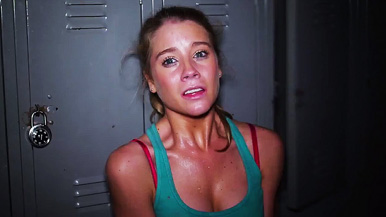Movie Review: The Gallows
By Ben Gruchow
July 16, 2015
Real quick, let’s make this clear: Night vision involves radiation on wavelengths that lie outside those of visible light. For a camera to see in total or near-total dark, two things are required: an imaging sensor capable of detecting infrared radiation, and infrared illuminators or lights themselves. To date, there is no smartphone on the market that possesses either of these; although there are plenty of “night vision” apps available for smartphones, these are nothing more than cosmetic variations on the standard camera. At their most advanced, they open up the camera’s iris to such a degree that there’s more digital noise than image; more often, they just apply a green tint to the existing camera image. And this is only for still photos; there is no app that I know of that does this with video.
Since several sequences in The Gallows are comprised of night-vision video off of a smartphone in pitch-black spaces, and yet illuminate most of the visible area (including, at one point, an entire auditorium), what we have here is, in fact, a science-fiction film. On that level: how refreshingly low-key it is that the technology present here is barely remarked upon, and utilized as it must exist in the future that the movie comes from: advanced to us in the present day, but just a normal part of life to four teenagers on the run from a corporeal killer ghost. I’m being sarcastic, of course, because the concept of The Gallows as rock-stupid found-footage sci-fi is at least slightly more novel than the reality of The Gallows as rock-stupid found-footage horror, and because I must mock the film in order to feel anything about it at all.
It’s not offensively rock-stupid, nor is it enjoyably rock-stupid. It’s just an unlikable movie about unlikable characters who wander around for an hour in undistinguished settings before meeting their ends in predictable ways. I’m very happy that I took notes during The Gallows, because otherwise I’d be having trouble remembering events in the order that they happened. Other than the presence of nonexistent night-vision technology, here are some other observations about the world in which we find ourselves:
- The very first scene - which is really just a single shot - has a kind of tension that evaporates as soon as the dialogue begins. The constant diegetic narration early on, which is stilted in both writing and acting, set the movie from the word “go” on an uphill climb to win me back.
- As the movie opens, the play that also functions as the title of the film is about to put on its first performance in 20 years, after a tragedy that resulted in the death of one of the original cast members. Despite these circumstances - and what we infer from the film’s spare dialogue was plenty of time to rehearse - the play’s cast members appear to have trouble understanding the very basics of theater, like speaking to the audience, to say nothing of their inability to remember their lines.
- Then again, it’s possible that the characters in the film know their lines perfectly, and they’re just at the mercy of the four flattest impressions of high schoolers I’ve witnessed in many a moon.
- There have been some found-footage movies that stretch the credibility of their gimmick, but The Gallows puts them all to shame. Imagine that you’re a high-school student with a video camera. Now imagine that you’re recording a conversation with your friend, and you randomly hit the Start and Stop buttons during the conversation, recording snippets of words and sentences without any rhyme or reason. In addition, you’re recording a conversation about the act of vandalism you plan on committing that night (to which you also bring the camera and evidently plan on recording). This is what the opening 30 minutes or so of the movie posit as reality. It does not get better.
The movie was written and directed by Travis Cluff and Chris Lofing, making their first theatrical feature on a budget of $100,000. They have set their film in an environment (consisting largely of backstage, above- and below-stage spaces and corridors) that makes the grade on visual creepiness, but that’s owing to its very nature. There were moments that succeeded in momentarily raising my pulse, but these owe more to the fact that they were jump scares, and the worst film in the world can convey an effective jump scare by turning up the volume. And there were several moments where the visuals and sound design combine to create sequences that are honestly eerie; I’m not a total buzzkill. On the level of basic competence in production design, The Gallows is occasionally acceptable. It isn’t an attractive movie - most of it is fairly ugly, actually - but it’s appropriate to the setup.
On virtually any other level - screenwriting, acting, editing, execution of its concept - it’s dead on arrival. The night before I saw The Gallows, I re-watched the horror indie It Follows. Here’s the thing: the second time around, It Follows lost much of its pulverizing tension from my theatrical viewing this past March; left behind was a magnificent exercise in mood and atmosphere, with well-written characters inhabited by convincing actors. It would be unrealistic of me to expect a minor entry in the Blumhouse stable to stand up by comparison, but is that ever faint consolation for what this movie has to offer.
|
|
|
|




